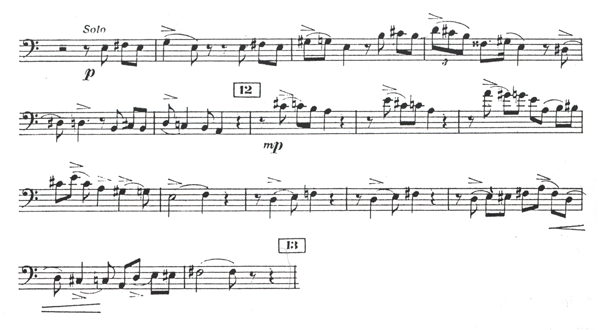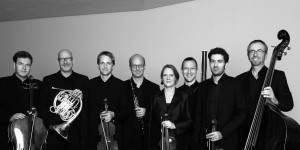Interview: Emmanuel Pahud, flute
A star flutist only comes around once or twice in a generation — and it’s fair to say that this generation’s strongest candidate is the Swiss-born Emmanuel Pahud. We sat down with the Berlin Philharmonic principal flutist last year about his upcoming Ann Arbor recital.
Emmanuel Pahud performs in Ann Arbor on Wednesday, February 14, 2018.
The Importance of Wind Instruments to early 20th-Century French Composers
Editor’s note: Berlin Philharmonic Wind Quintet perform a program of wind pieces on February 9, 2013 in Hill Auditorium

Image: Score excerpt from Darius Milhaud’s La Création Du Monde.
It is easy, when listening to music, to become so enthralled with the serendipitous sound of the performers in front of us, or in our pockets, that we forget their instruments are pieces of technology that developed through time and experimentation. Of the instruments common to classical music, wind instruments represent the ‘youngest’ generation of devices conceived and constructed to produce new musical sounds.
Consider this: when legendary luthier Antonio Stadivari, whose violins continue to be played to this day, died in 1737, none of the instruments you will hear on February 9th’s Berlin Philharmonic Wind Quintet concert had been modernized. In fact, only the flute, of the other instruments on stage, can trace its direct ancestry so far back in time, with early method books for the transverse flute (which, at that time, were made of wood) appearing around the turn of the 18th-century.
Early forbearers of the modern oboe and clarinet emerge in the same century, drawing, as one would expect, the curiosity of the era’s leading composers. Mozart (an arrangement of whose Fantasy for Mechanical Organ is on the Berlin Philharmonic Wind Quintet’s program) possessed a famous fascination with the clarinet and wrote specifically for ensembles with access to these newly invented instruments. Over the course of the 19th century, we see brass instruments, like the French Horn, and the piano arrive at their modern forms, with integrations of these instruments, and others, into symphonic, opera and chamber settings.
Stravinsky’s Octet for Winds
Although instrument invention became far more experimental in the 1900s, we see composers – particularly French composers in the first few decades of the century – embrace the class of wind instruments, many of which had only recently been standardized, in their compositions. Although written earlier than the works of Darius Milhaud, Jacques Ibert and Francis Poulenc performed by the Berlin Philharmonic Wind Quintet, Stravinsky’s Octet for Winds (1922) and Milhaud’s La Création Du Monde (1923) are historically decisive works that prominently feature unconventional groupings of wind instruments.
Despite the fact that the genre and ensemble of the wind quintet has been present in classical music since the early 1800s, the works of Poulenc, Milhaud and Ibert featured on the upcoming concert provide further evidence of how important wind music was to early 20th century French composers’ definition of modernity. Additionally, Kalvi Aho’s Windquintet (2006) demonstrates the ensemble’s endurance as a music force, maintaining wind instruments’ sense of pertinence in the early stages of the 21st Century.
The Berlin Philharmonic Wind Quintet on the roof of the “Berliner Zeitung” building
The Inside Scoop: Chamber musicians of the Berlin Philharmonic
Some people like to attend a performance with a blind ear, letting the musical experience wash over them afresh. Others like a more informed approach, seeking out the musical particulars that promise to make an ensemble’s approach to their program unique. Guest blogger and U-M graduate student composer Garrett Schumann is the latter type of audience member and brings us this glimpse of what we can expect to hear from the chamber musicians of the Berlin Philharmonic, the Scharoun Ensemble Berlin, this Wednesday evening in Rackham Auditorium.
Wednesday night’s performance by the Scharoun Ensemble Berlin – chamber musicians from the Berlin Philharmonic comprising an octet of string quartet, contrabass, horn clarinet and bassoon – will certainly present new instrumental textures to its audience. The evening’s program revolves around Schubert’s major chamber work, Octet in F Major, an arrangement of Anton Dvořák’s Czech Suite in D Major and also includes a very new work for octet by composer Keeril Makan entitled Tender Illusions.
As evidenced by this collection of pieces, groups like the Scharoun Ensemble who adore performing Schubert’s Octet typically depend on arrangements and new commissions to fill their repertory. In fact, this reality is closely tied to the Octet’s origins: Schubert received the commission from Austrian noble Count Ferdinard Troyer who – being an amateur clarinetist – sought a new chamber work he could perform alongside Beethoven’s Septet. Schubert deviated from this model by adding a second violin, but structured the piece very similarly to Beethoven’s work.
The Octet’s instrumentation gives the work a very unusual and personal character, particularly because its winds have a very condensed spectrum of register. The horn and bassoon have similar ranges, though the bassoon is more of a bass instrument, which automatically makes the clarinet extremely prominent, a fact not lost on Schubert. Prepare to identify the clarinet as an important melodic role-player in the work, namely in the second movement where it introduces the primary theme above accompanying strings. Along these lines, the absence of a flute incidentally adds brightness to solo violin passages: our ears yearn for a more piercing soprano sound than the warmth of the clarinet and the violin is the only instrument we hear in the Octet whose range enters the heights we expect from a full compliment of orchestral winds. Beyond the uncommon makeup of Schubert’s ensemble, the ways he combines these instruments are particularly stunning and remarkable.
To my ears, I am always impressed by the delicacy with which Schubert treats the contrabass, whose sonic breadth further imbalances the low end of the ensemble’s range. The scherzo third movement demonstrates the weight of the contrabass as Schubert contrasts a primarily loud minuet featuring the whole ensemble with an elegant trio in the movement’s mid-section. Here, the contrabass is pretty much absent, engendering the music with a refreshing lightness. Of course, contrabass players are capable of being quite sensitive with their instruments, which Schubert knew as well. Just listen for the expressive and agile triplet arpeggios in the contrabass part in the second variation of the fourth movement; you’ll know you’re here because it is the first point in the piece where the horn and bassoon play.
These and other textures will certainly populate Ulf-Guido Schäfer’s arrangement of Anton Dvořák’s saccharine Czech Suite in D major, which the composer began writing in March 1879. Deeply nationalistic, this work is full of musical references to Dvořák’s homeland a Bohemian-style minuet – the “Sousedeska” – and many folk tunes. Although intended for full orchestra, the piece is very heavy on winds and should suit the Scharoun Ensemble quite well. The final two movements – “Romance” and “Finale” – open with wind solos accompanied by strings, but feature oboe and flute, not the Scharoun ensemble’s lone clarinet. The arrangement’s approach to these sections will be especially interesting to discover in light of Schubert’s treatment of register in the Octet. Will the violin simply cover these high wind parts? Or, will the clarinet play them lower to maintain the general color of the moment: wind solo against strings?
In contrast to Schubert’s unique Octet, the Czech Suite comes from a long line of 18th and 19th century orchestral compositions dubbed, “serenades.” These works – such as Mozart’s beloved Eine Klein Nachtmusik – were like the easy listening music of the day; simple forms with straightforward ideas and clear textures. These characteristics make the Czech Suite transparently evocative, depicting an idealized Bohemian landscape and culture in its melodies, rhythms and orchestral spacing. Very little of these qualities should be lost in the hands of the Scharoun Ensemble’s smaller instrumental battery; if anything, the scene Dvořák attempts to paint will appear more intimate. Clearly, Dvořák’s full palette of orchestral colors is trapped in the work’s original version. Yet – as we saw with Schubert’s Octet – a group like the Scharoun Ensemble is capable of a vast number of textures, which should prove and exciting arena in which to hear the Czech Suite.
With these more traditional octet applications in mind, we will turn to composer Keeril Makan’s new octet composition Tender Illusions. The Scharoun Ensemble premiered the piece on March 6th, so it is safe to say Mr. Makan’s work is the absolute cutting edge of octet writing. Mr. Makan’s website provides interested parties with sound bites of a diverse range of works for small and large ensembles. The pieces Mr. Makan showcases on his site range from the highly aggressive string quartet and electro-acoustic works The Noise Between Thoughts and Threads to the slowly unfolding, introverted and contemplative solo piano work Afterglow.
It is impossible to say what Tender Illusions will sound like, but it is clear from the works Mr. Makan chooses to share that he has an affinity for rhythm and creates very clear, visceral musical textures. Keeping those pieces in mind, I imagine Tender Illusions will employ some unconventional instrumental techniques – just listen to the string quartet writing in The Noise Between Thoughts – but not for the sake of experimentation. Based on Mr. Makan’s comments about The Noise Between Thoughts, he chose anguishing string sounds to effect a clear expressive – and in this case, political – goal. In light of this, I can assure Wednesday’s audience members that Mr. Makan will pursue all necessary force to express his goal in Tender Illusions. Whether violent or reflective, I have no doubt you will walk away from Rackham Auditorium having felt the emotional impression Mr. Makan hopes to convey, regardless of its complexity.
Armed with Mr. Makan’s Tender Illusions, the Czech Suite and Schubert’s Octet, the Scharoun Ensemble should also leave an indelible mark on its audience. Their instrumentation grants them much of the breadth of an orchestral group, but also allows for the flexibility and intimacy audiences love in chamber music. Wednesday’s concert will not only display the individual and cohesive excellence of the Scharoun Ensemble, it will also present a wide range of musical textures and styles. Every listener should be pleased and blown away.



